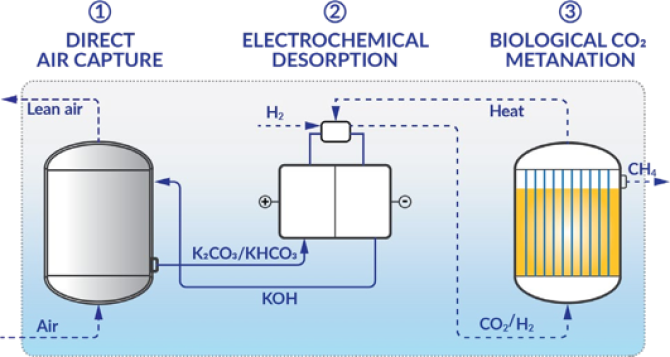
Project
Integration of direct air capture and biological processes for sustainable production of methane
Carbon capture and utilization (CCU) is one of the strategies proposed for mitigating dependency on fossil resources. Direct air capture (DAC) technologies are able to capture CO2 directly from ambient air [1]. The captured CO2 can be used as commodity for multiple purposes or as a carbon feedstock for chemical production. A particularly interesting product is methane. With CO2 and H2 as feedstock, biomethanation reactors are able to produce grid-quality (>95%) methane [2].
Biological CO2 methanation take place in anaerobic, mild conditions [3], with pH range between 6.2-8.5 and temperature between 35-40°C (mesophilic) or 55-65°C (thermophilic), according to the following reaction,
4𝐻2 + 𝐶O2 → 𝐶𝐻4 + H2O ∆𝐺0 = -165 KJ/mol
This research seeks to develop an energy-efficient process to produce renewable and biomass-free methane, by integrating a previously described electrochemically-assisted DAC[4] unit and biological CO2 methanation step.
Technological challenge
Typically the electrochemical system can be characterized as fast-responding with extreme conditions, whereas the bioreactor operates best at mild and stable conditions. To integrate the electrochemical unit with the bioreactor unit, the
balance between these two systems is crucial.
Mass flows need be explicitly tuned to sustain a stable substrate/product balance for biomethanation. Heat and pH need to be managed to keep methanogens at optimal metabolic activity. Finally, to reach efficient methane production, individual mass and energy flow need to be optimized in terms of energy requirements (kJ/mol CO2), and product yield (mol CH4/m3 air).

Research goals
The research will be organized into three main objectives:
• Reach stable performance for integrated DAC with electrochemical desorption
• Optimize conditions for CO2 conversion to methane via biological CO2 methanation
• System integration and overall process optimization
[1] Sanz-Pérez, E.S., et al., Direct Capture of CO2 from Ambient Air. Chemical Reviews, 2016. 116(19): p. 11840-11876.
[2] Rusmanis, D., et al., Biological hydrogen methanation systems – an overview of design and efficiency. Bioengineered, 2019. 10(1): p. 604-634.
[3] Lecker, B., et al., Biological hydrogen methanation – A review. Bioresource Technology, 2017. 245: p. 1220-1228.
[4] Shu, Q., et al., Electrochemical Regeneration of Spent Alkaline Absorbent from Direct Air Capture. Environmental Science & Technology, 2020. 54(14): p. 8990-8998.
This research received funding from Dutch Research Council (NWO) in the framework of NWO Wetsus Partnership Programme on Sustainable Water
Technology, under project number ENWWS.2020.004.